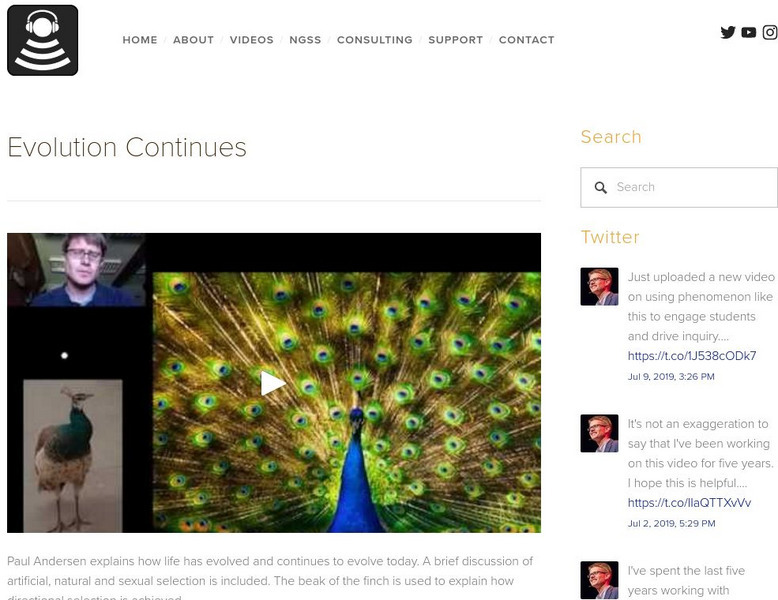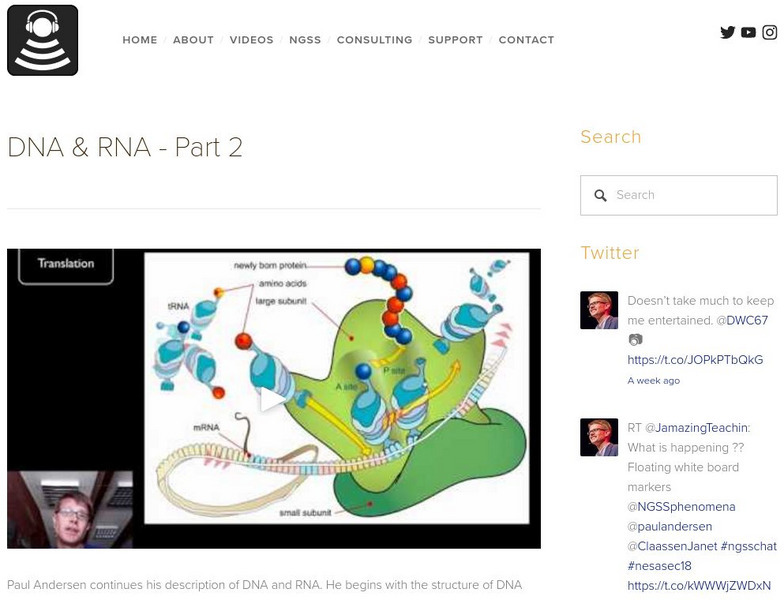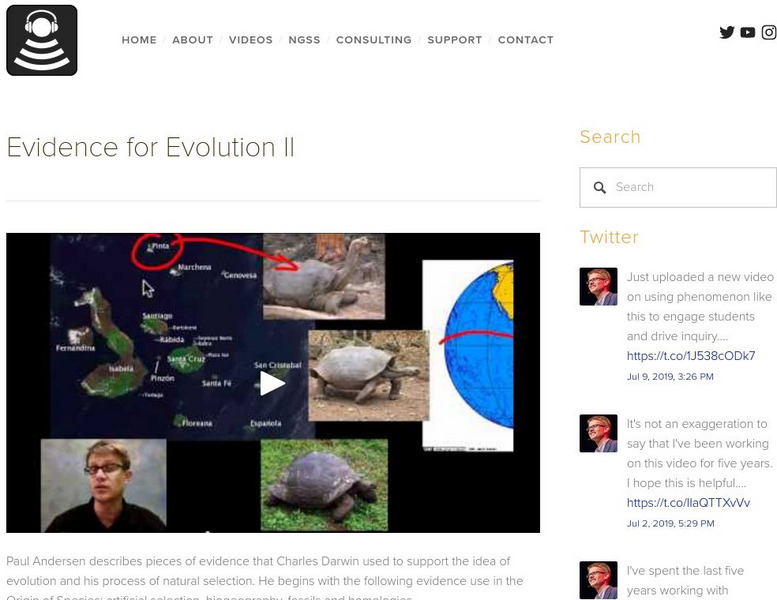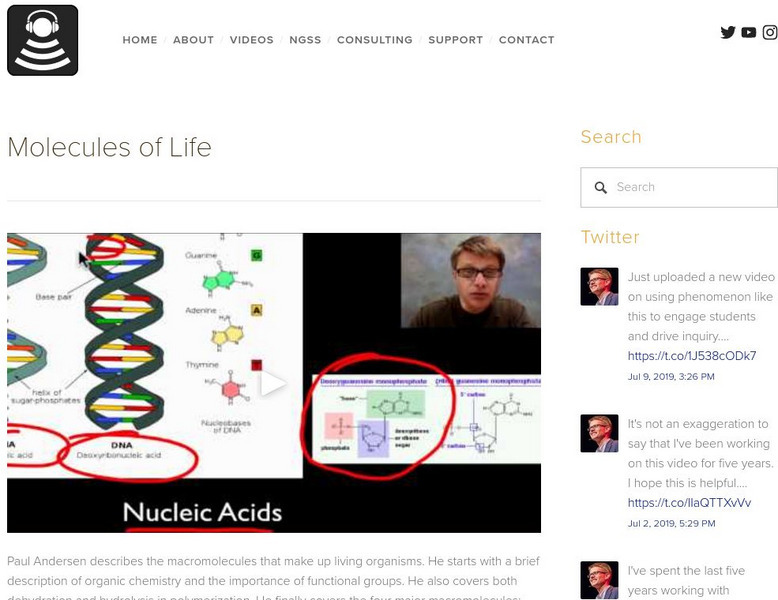Hi, what do you want to do?
Bozeman Science
Bozeman Science: Waves
Mr. Andersen introduces the concept of waves. Both transverse and logitudinal waves are described. The relationship between wave speed, wave frequency and wavelength is also included.
Bozeman Science
Bozeman Science: What Is Dna?
Paul Andersen describes the molecular structure of DNA. He describes the major parts of a nucleotide and explains how they are assembled into a nucleic acid. The nitrogenous base, deoxyribose sugar and phosphate group make up a single...
Bozeman Science
Bozeman Science: What Is Physics?
Mr. Andersen explains the importance of physics as a science. History and virtual examples are used to give the discipline context.
Bozeman Science
Bozeman Science: Why Are Cells Small
The lower half of Mr. Andersen's head explains why cells are small. This video begins with a simple geometry problem and ends with a discussion of Allen's Rule and reasoning for the microscopic nature of cells.
Bozeman Science
Bozeman Science: X Inactivation
Paul Andersen explains how X inactivation works in mammals. This process was first described by Mary Lyon. Each cell in a female will have on activated and one inactivated X chromosome. This explains why almost all calico cats are female.
Bozeman Science
Bozeman Science: Evidence for Evolution
Paul Andersen lists major evidence for the existence of evolution. He begins with a discussion of Charles Darwin and the evidence that he presented in the Origin of Species, including biogeography, fossils, and homologies. He also...
Bozeman Science
Bozeman Science: Evolution Continues
Paul Andersen explains how life has evolved and continues to evolve today. A brief discussion of artificial, natural and sexual selection is included. The beak of the finch is used to explain how directional selection is achieved.
Bozeman Science
Bozeman Science: Development: Timing and Coordination
Paul Andersen explains how genes control the timing and coordination of embryo development. Seed germination initiates the discussion of cell differentiation. The SRY gene and genetic transplantation shows the importance of embryonic...
Bozeman Science
Bozeman Science: Mechanisms of Timing and Control
Paul Andersen explains how organisms regulate timing and control. Phototropism and Photoperiodism allow plants to respond to light throughout the day and year. Circadian rhythms are used in all organisms (including animals) as an...
Bozeman Science
Bozeman Science: Part 2 Dna & Rna
Paul Andersen continues his description of DNA and RNA. He begins with the structure of DNA and RNA and moves into the process of DNA Replication. He also describes the central dogma of biology explaining how DNA is transcribed to mRNA...
Bozeman Science
Bozeman Science: Biologoical Molecules
Paul Andersen describes the four major biological molecules found in living things. He begins with a brief discussion of polymerization. Dehydration synthesis is used to connect monomers into polymers and hydrolysis breaks them down...
Bozeman Science
Bozeman Science: Anaerobic Respiration
Paul Andersen explains the process of anaerobic respiration. This process involves glycolysis and fermentation and allows organisms to survive without oxygen. Lactic acid fermentation is used in animals and bacteria and uses lactate as...
Bozeman Science
Bozeman Science: Animal Behavior
Paul Andersen steps you through eight types of animal behavior. He starts by defining ethology and explaining that behavior varies from innate to learned. He discusses each of the following with examples; instinct, fixed action pattern,...
Bozeman Science
Bozeman Science: Earth Materials & Systems
In this video, Paul Andersen describes the four major spheres on planet Earth. The geosphere makes up the mass of the planet and includes the major landforms. The hydrosphere is all of the water and the atmosphere is all of the gases....
Bozeman Science
Bozeman Science: Developing Possible Solutions
In this video, Paul Andersen explains how many possible solutions are developed in the design process. As many solutions to the problem are identified using a brainstorming process. These solutions are compared to the specific...
Bozeman Science
Bozeman Science: Optimizing the Design Solutions
In this video, Paul Andersen explains how engineers optimize the design solution. After a number of solutions have been identified engineers will test each of them against a given set of criteria. They will trade-off different phenomenon...
Bozeman Science
Bozeman Science: Interdependence of Science, Engineering & Technology
In this video, Paul Andersen explains how science is dependent upon engineering which is dependent upon science which is dependent up engineering which is dependent upon science which is dependent up engineering which is dependent upon...
Bozeman Science
Bozeman Science: Evidence for Evolution Ii
Paul Andersen describes pieces of evidence that Charles Darwin used to support the idea of evolution and his process of natural selection. He begins with the following evidence use in the Origin of Species; artificial selection,...
Bozeman Science
Bozeman Science: Logistic Growth
Paul Andersen explains how populations eventually reach a carrying capacity in logistic growth. He begins with a brief discussion of population size ( N ), growth rate ( r ) and exponential growth. He then explains how density dependent...
Bozeman Science
Bozeman Science: Variation of Traits
In this video, Paul Andersen explains how variation is created in a population over time. Variation in offspring is caused by genetic recombination, mutations and environmental effects. Parental DNA is recombined using the process of...
Bozeman Science
Bozeman Science: Molecules of Life
Paul Andersen describes the macromolecules that make up living organisms. He starts with a brief description of organic chemistry and the importance of functional groups. He also covers both dehydration and hydrolysis in polymerization....
Bozeman Science
Bozeman Science: Human Impacts on Earth Systems
In this video, Paul Andersen explains how humans are impacting the Earth through farming, mining, pollution and climate change. According to the NGSS wise management can reduce impacts on the planet. This will become more important as...
Bozeman Science
Bozeman Science: Optimizing the Design Solution
In this video Paul Andersen explains how engineers optimize the design solution. After a number of solutions have been identified engineers will test each of them against a given set of criteria.
Bozeman Science
Bozeman Science: Biology Video
Paul Andersen introduces the topic of Biology. He covers each of the four main ideas that were developed by the College Board. These ideas revolve around the concepts of evolution, free energy, information and systems.




























